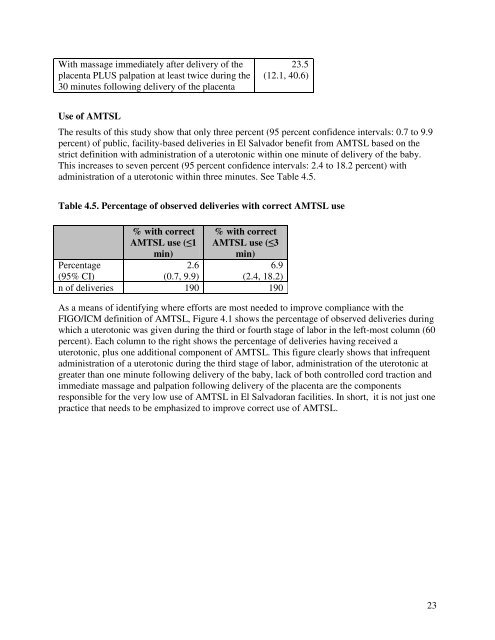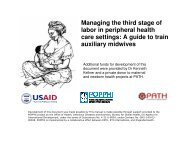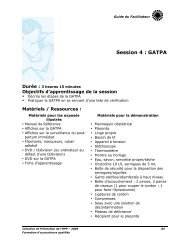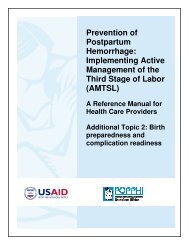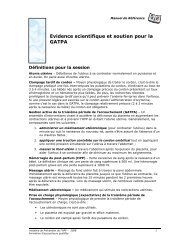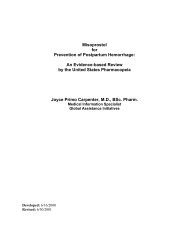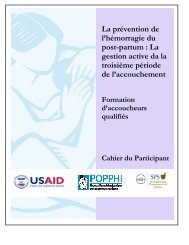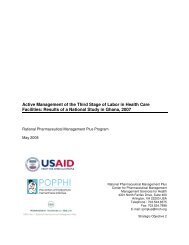El Salvador - Active Management of the Third Stage of Labor - POPPHI
El Salvador - Active Management of the Third Stage of Labor - POPPHI
El Salvador - Active Management of the Third Stage of Labor - POPPHI
Create successful ePaper yourself
Turn your PDF publications into a flip-book with our unique Google optimized e-Paper software.
With massage immediately after delivery <strong>of</strong> <strong>the</strong>placenta PLUS palpation at least twice during <strong>the</strong>30 minutes following delivery <strong>of</strong> <strong>the</strong> placenta23.5(12.1, 40.6)Use <strong>of</strong> AMTSLThe results <strong>of</strong> this study show that only three percent (95 percent confidence intervals: 0.7 to 9.9percent) <strong>of</strong> public, facility-based deliveries in <strong>El</strong> <strong>Salvador</strong> benefit from AMTSL based on <strong>the</strong>strict definition with administration <strong>of</strong> a uterotonic within one minute <strong>of</strong> delivery <strong>of</strong> <strong>the</strong> baby.This increases to seven percent (95 percent confidence intervals: 2.4 to 18.2 percent) withadministration <strong>of</strong> a uterotonic within three minutes. See Table 4.5.Table 4.5. Percentage <strong>of</strong> observed deliveries with correct AMTSL use% with correctAMTSL use (≤1min)2.6(0.7, 9.9)% with correctAMTSL use (≤3min)6.9(2.4, 18.2)Percentage(95% CI)n <strong>of</strong> deliveries 190 190As a means <strong>of</strong> identifying where efforts are most needed to improve compliance with <strong>the</strong>FIGO/ICM definition <strong>of</strong> AMTSL, Figure 4.1 shows <strong>the</strong> percentage <strong>of</strong> observed deliveries duringwhich a uterotonic was given during <strong>the</strong> third or fourth stage <strong>of</strong> labor in <strong>the</strong> left-most column (60percent). Each column to <strong>the</strong> right shows <strong>the</strong> percentage <strong>of</strong> deliveries having received auterotonic, plus one additional component <strong>of</strong> AMTSL. This figure clearly shows that infrequentadministration <strong>of</strong> a uterotonic during <strong>the</strong> third stage <strong>of</strong> labor, administration <strong>of</strong> <strong>the</strong> uterotonic atgreater than one minute following delivery <strong>of</strong> <strong>the</strong> baby, lack <strong>of</strong> both controlled cord traction andimmediate massage and palpation following delivery <strong>of</strong> <strong>the</strong> placenta are <strong>the</strong> componentsresponsible for <strong>the</strong> very low use <strong>of</strong> AMTSL in <strong>El</strong> <strong>Salvador</strong>an facilities. In short, it is not just onepractice that needs to be emphasized to improve correct use <strong>of</strong> AMTSL.23


